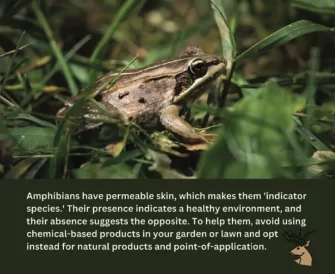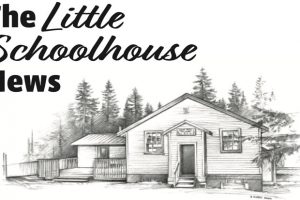Planning for Spring Wild-Safe Way
When we look out our windows, we see Winter is waning and Spring is slowly emerging in our community! With vernal warming just ahead and local wildlife slowly moving back into their seasonal habitats, there are practical resilience measures we can take to ensure wildlife and people flourish in the Spring season of new life and regrowth.
Geese can be heard honking on Louis Lake (Antler Ridge Pond). Soon wood frogs will join their chorus, backed by calls of loons with the movement of the seasons. Birdsong reminds us to be mindful of riparian habitat – the fringe areas around ponds, wetlands and streams, where eggs lay in hidden nests and tadpoles swim, undetected by predators. We can help protect this emerging life by maintaining a 10-foot distance from the edge of any water body until we determine there are no signs of nesting birds or amphibians (frogs, toads, and salamanders) in the area.

Amphibians have a permeable skin which makes them Indicator species. They indicate a healthy environment when they are present and an unhealthy environment when they are absent. Natural systems are more than skin-deep; amphibians literally absorb everything we put into their habitat. This is important to remember when we begin our garden and lawn care preparations. Avoid phosphate and sulfate-based fertilizers and opt instead for point-of-application – utilize worm castings, egg shells, manure or compost and soil amendments like blood meal, bone meal or mulch. Local bears are attracted to smelly stuff, so ensure these substances are thoroughly mixed into the soil at the recommended proportions. Mulching in old plant material eventually negates the need for using fertilizer at all. We can witness nature’s actions for ourselves when we observe the forest floor.
Spring runoff will soon fill water bodies and the ditches and swales around our homes. Make sure your culverts and overland drainage paths are clear of obstacles to let water find its way back into the hydrologic cycle. Quality river habitat is supported by sufficient water volumes, while allowing our groundwater to recharge in a resilient cycle that protects precious drinking water.
Overland flow carries sediment (soil particles), oil, lubricant, paint, salt and other remnants of winter maintenance. These pollutants impair drinking water quality, groundwater quality and aquatic habitat. They end up in our soil, groundwater and gardens, harming micro- organisms, worms, spiders, insects, and other soil-benefitting creatures. They get eaten by birds, small mammals and deer, accumulating toxins up the food chain. This process, known as bioaccumulation, causes birth defects and poor fertility in wildlife (and humans). The onus is on all of us to clean up contaminants in our driveways and yards and avoid washing vehicles and buildings by limiting excess water use and avoiding harmful chemicals.
On a final note, remember that many animals LOVE birdseed. Bird feeders aren’t needed when Spring allows for natural foraging behaviour by warblers, kinglets, juncos, and grosbeaks revisiting from warmer climes, along with the resident nuthatches and chickadees who share our beautiful local environment year-round.
Happy Spring from all of us at YOUR Bragg Creek WILD!
Bragg Creek Wild – www.braggcreekwild.ca braggcreekwild@gmail.com – 403-200-9961 People and wildlife living in community


























